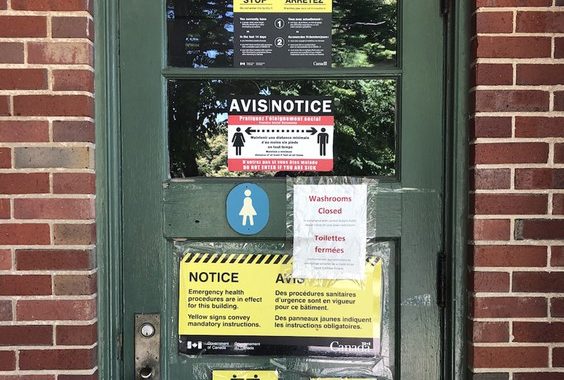Freshdaily News, June 2020
Olivia Little
Public washroom access has long been an issue for those experiencing homelessness, as well as trans and disabled individuals – though it’s something each one of us can relate to.
And it’s been drawing even more attention recently with business closures and prolonged reopenings limiting our options when it comes to using the loo.
A member of GottaGo! a group campaigning for more toilet access in Ottawa, Bessa Whitmore says most of our public toilets in Canadian cities are in private businesses. “Coffee shops, like Timmies, and many others have become de facto public toilets. Cities are starved for funds and it’s easier to just have [private businesses] fill the void.”
Offering stand-alone, municipality-funded public washrooms isn’t something Canada does very well.
Here’s the public washroom situation in some of the major cities across Canada.
Toronto
Public washrooms are practically nonexistent with only three stand-alone lavatories laid out along the waterfront. There were supposed to be 20 of these installed but that plan was suspended in 2013 after the funds were redirected to the city’s bike-share network.
There’s also one year-round permanent 9 a.m. to 10 p.m. washroom facility at Nathan Phillips Square. And a number of park washrooms that are beginning to reopen – though these also close at night and during the winter.
Toronto has taken some temporary measures during COVID-19. Eight portable washrooms and handwashing stations and six additional locations with showers and access to drinking water have opened for the city’s homeless.
Ottawa
Currently, there are no stand-alone public toilets in Ottawa. And all of the 200 toilets listed by the City have limited hours of operation, located within businesses, or require a special key or buzzer to access in the case of those at Alta Vista, Rideau and Rosemount library branches.
The City did add toilets to 16 parks a few years ago adding to its pre-existing fleet of 45. But these close at night and during the winter. Five of these at public beaches and parks are beginning to reopen across the city. Nine porta-potties have also been installed during COVID-19.
Vancouver
Vancouver has 11 stand-alone, free-to-use, self-cleaning facilities around the city. Eight of which are open around the clock and three from 6 a.m. to 10 p.m. Still, that’s not a lot considering the 100,000 people living downtown, over 2,200 homeless individuals, and nine million visitors each year.
There are also 15 parks with public washrooms that operate within specific hours and the city requires all buildings to have accessible washrooms for tenants and users. But businesses have been pushing for more 24-hour stand-alone facilities after increased incidents of open defecation in the city.
Halifax
The situation is pretty dire in Halifax when it comes to public washrooms. They have installed two portable washrooms and a handwashing station behind the Central Library in downtown Halifax due to the pandemic. But these are only accessible for eight hours a day.
Aside from these porta-potties, there are municipal washrooms in the North Commons, skating pavilion and the Halifax Public Gardens, which are now reopened, but also close during the night and during the winter.
Halifax columnist and author of No Place to Go: How Public Toilets Fail our Private Needs, Lezlie Lowe, says there just aren’t many public washrooms in Halifax once these close for the day. “And the ones we do have aren’t winterized.”
Montreal
The City signed a contract to bring in a total of 12 stand-alone, free-to-use public washrooms, with the first two facilities installed in the downtown core a few years ago. Four have been installed so far (shown in blue on the map) and three more will be coming in 2022 (shown in red), according to an email comment from the City of Montreal.
The public toilets that are cleaned twice daily, on top of the automatic self-cleaning, in which the floors, toilet and sink are sprayed down after every use, have generated a positive response from both residents and visitors and are used 80 to 100 times a day.
Winnipeg
With no stand-alone municipality-funded washrooms in the city, public toilet access has been a long time coming in Winnipeg. But there’s been more than enough advocacy around the issue. A pop-up pilot project a few years ago involved a few organizations transforming a shipping container into a two-stall washroom downtown.
This sparked a decision for the City to revisit a 10-year-old public washroom report and the revised plan is set to be introduced in the coming weeks.
During the lockdown, community organizations have been setting up portable washrooms in front of their buildings, including 1JustCity that put one outside their Crossways in Common location and Resource Assistance for Youth, which installed one outside its location on Sherbrook Street.
Edmonton
Though Edmonton has over 114 public washrooms either within parks, public buildings, LRT stations, or private businesses, the city has no current bylaw requiring retailers to have public washrooms for customers. And the ones that do are usually reserved for paying customers.
Edmonton is working on a three-phase planning model to address public washroom access citywide, which includes piloting a 90-day monitoring program for the public washroom on Whyte Avenue. An attendant has been serving as host to the washroom users and maintaining the facility.
If you’re ever in a pinch in any one of these cities, the GoHere app, created by Crohn’s and Colitis Canada can help you instantly locate a washroom nearby.
Why are there not more public washrooms in Canadian cities?
High Cost
It will cost Montreal $300,000 each to install the 12 public toilets. And then there’s the cost of paying for upkeep and washroom attendants. Though it means additional cost for the city, Whitmore points out that it can help provide more jobs for out-of-work residents; “That’s a cost but it’s also a source of employment if you pay people decently.”
The three-month monitoring pilot in Edmonton created four new full-time jobs, two part-time and four casual positions, according to Boyle Street Ventures Inc. GM Jodi Phelan.
There are also more cost-effective alternatives like subsidizing businesses to keep a sign in their windows letting people know that their washrooms are open for public use. This has been done in Germany and may also be explored in Winnipeg when revisiting the 2010 report.
Cold Climate
The fact that Canada has long, cold winters also makes the installation of these public washrooms that much more pricey. “We need toilets that can be kept open 24-7 but in a city like Ottawa, which freezes in the winter, hook-ups to water and sewer can be very expensive,” says Whitmore.
Pierrefonds, a suburb outside of Montreal, which has similar winters to Ottawa, found a cheaper alternative and has three dry composting toilets that cost about $50,ooo each.
Persisting Stigma
Whitmore says public toilets are also often stigmatized. “People say, ‘Oh they’ll shoot up in them. They’ll have sex in them. They’ll sleep in them.’” She adds that this can simply be avoided by staffing them properly, keeping them clean and providing more resources for those who are homeless.
Stephanie Taylor, a fellow member of GottaGo! Ottawa, adds, “It’s a combination of bodily shame and we don’t have the language to have a frank discussion about what our needs are. It’s a private act and we avoid it.”



